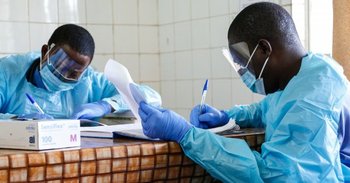The ALNAP lessons paper ‘Responding to Ebola epidemics’ found a lack of consensus across existing research about which coordination model is most effective in Ebola responses. The only clear lesson that emerged from available documents was a need to ‘clarify roles and responsibilities for all actors in each context’ in future humanitarian responses to Ebola. Newly published research asks: are roles and responsibilities the only issue at play?
The 10th Ebola outbreak in the Democratic Republic of Congo was declared in August 2018 and ended in June 2020, after becoming the second-largest Ebola outbreak in the world. Because the outbreak was declared a health crisis, the international response was initially led by the World Health Organization (WHO). However, when the outbreak could not be contained – in part due to it occurring in a conflict setting with ongoing humanitarian needs – the Inter-Agency Standing Committee (IASC) Humanitarian System-Wide Scale-Up Activation Protocol for the Control of Infectious Disease events (or ‘scale-up’) was activated, involving the rest of the UN. An ad-hoc Ebola Emergency Response Team, led by an official from the UN Country Team, initiated a more holistic approach to the response, more akin to a humanitarian response. This new structure ran parallel to the initial health-response structure, led by the Ministry of Health with support from WHO, creating inefficiencies and confusion.
Recent HPG research into the leadership of this epidemic found that the primary issue was not a lack of clarity around roles and responsibilities, but rather a fundamental disagreement between key stakeholders over what kind of response it should be and thus who should be in charge.

In future responses, while it’s true that roles and responsibilities for each actor need to be clarified, three things need to be prioritised higher:
- Prioritise the response, not organisational politics.
The main goal of any Ebola response should be controlling the disease and supporting the affected communities. In the 10th response, the parallel structures set up were a compromise solution to manage differing opinions over who should lead and what type of response it should be. The result was delays and difficulties. In future responses, organisations should be more honest about their strengths and weaknesses and work together in complementarity to implement an efficient and effective response.
- Follow the protocols properly.
The 10th Ebola outbreak was the first test for the IASC scale-up protocol, but it was not activated as intended. Thus, it is difficult to tell whether the protocol is appropriate for this type of emergency. For example, the protocol does not call for parallel structures, but rather a WHO Representative to be appointed as Deputy Humanitarian Coordinator, underneath the UN Humanitarian Coordinator (or Resident Coordinator re-hatted as a Humanitarian Coordinator), and the activation of the cluster system. There is an agreed coordination model which sets out the roles and responsibilities, and it needs to be followed as written.
3. Focus on the true objective: long-term health capacity.
Now that there are successful therapeutics and vaccines for Ebola, there’s no reason a ‘global health security’ approach – with outcomes focused on stopping the spread of Ebola to the Global North – should be prioritised over the needs of affected communities.

Instead, future outbreaks should be treated as part of a community’s overall health needs. This includes, paradoxically, spending less money on the response as the massive influx of Ebola-specific money in the 10th response fuelled exploitative ‘Ebola business’, skewed health and humanitarian priorities and did little or nothing to build longer-term health capacity in DRC. Future responses should focus on building better and more sustainable public health structures, prepared to handle future outbreaks without the automatic support the of the international community.